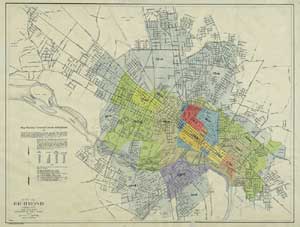RECENT COMMENTS
ACORN’s Researching the History of Your House
ACORN‘s 5th Annual Susan Carter Williams Memorial Seminar, Researching the History of Your House, this morning at the Library of Virginia included the presentations Architectural Eras, Styles and House Types by Kim Chen , Your Historic Property: Detective Work at the Library of Virginia by Vince Brooks, Resources available at your Main Public Library by Harriet Henderson, Property Record Evidence at the John Marshall Courthouse by Michael Dodson, and Uncovering Clues at the Valentine Richmond History Center by Meg Glass.
First up was Kim Chen (Architectural Historian, Johannas Design Group, ACORN board member) with Architectural Eras, Styles and House Types, a quick look at 300 years of architectural history.
Resources:
- Dictionary of Building Preservation by Ward Bucher
- Illustrated Glossary on Early Southern Architecture and Landscape by Carl R. Lounsbury
- the Church Hill Association‘s Living With History
- What Style Is It? (deals more with high style houses)
- A Field Guide to American House (by Virginia and Lee McAlester)
American Architectural Eras:
- Colonial (1600-1820); Postmedieval English, Georgian, Adam, Early Classical Revival; most of Postmedieval English are mostly gone. (Bacon’s Castle – Surry County VA 1655); Adam (Federal, Jeffersonian): first truly American style (example: Brickland, Lunenburg County [PDF])
- Romantic Houses; Greek Revival (1825-1860); Gothic Revival (1840-1880); Italianate (1840-1885)(*many* examples around Richmond); Exotic Revivals (1835-1890)
- Victorian (1860-1900): urban, mass produced — Second Empire – some in RVA, mansard roof; Queen Anne – “an homage to the machine”, balloon-frame, new forms, elaboration of form; Richardson Romanesque (some of Franklin)
- Eclectic (1880-1940)(a very creative period)- by influence, often combined: (RVA Old City Hall)(Main St Station)(details define buildings); American/English/French
Mediteranean (Mission, Spanish, Italian Renaissance); Modern American (Art Deco, Craftsman) - After 1950 – “disposable architecture”
Your Historic Property: Detective Work at the Library of Virginia by Vince Brooks (Senior Local Records Archivist – Library of Virginia)
Some resources:
- Virginia Historical Inventory (documentation of vernacular architecture in Virginia)
- Richmond Esthetic Survey – photos and info on some buildings in Richmond
- T.Crawford Redd & Bros., Plats & Surveys (1786-1952) – at Library of VA; will show footprint of structure, roads and alleys, property lines.
- Mutual Assurance Society of VA, Property Declarations & Revaluations (1796-1966) – basically a property assessment, will have drawing of footprint; pre-1865 info is online, early and later info is in LVA.
- Richmond City Building Permit Office – 1907-1976; start on microfilm with the permit applications; can have blueprints, drawings; more.
- Richmond Property Assessment Records – 1934-1977; Richmond City, Reels 477-699
- Sanborn Fire Insurance Maps – footprint of house and surrounding properties, roads, alleys, outbuildings; construction material; addresses.
- General Atlases, General Maps, Board of Public Works Maps
He also mentioned the publication Researching Your Historic Virginia Property (PDF).
Brooks referenced a map avilable at the LVA that shows the territorial growth of the City of Richmond, indicating when which areas were annexed from Chesterfield and Henrico Counties. A copy of this map is available for sale at The Virginia Shop at the Library of Virginia.

Resources available at your Main Public Library Harriet Henderson (Richmond Public Library Director) – Richmond Public Library)
- Richmond City Assessment Records (1933-1960); need map reference number
- City Council Minutes – for any special use permits, etc
- City Directory – searchable by name, address, or phone number (1852-present)
- Phone Books – 1912, 1925-1926, 1930-present
- Newspaper Clipping Files – background info about neighborhoods, architects, more; more info
Property Record Evidence at the John Marshall Courthouse by Michael Dodson – Planner K.W.Poore & Associates, ACORN Board Member.
Records room on G-level. Open 8:45AM to 4:45PM. An easy quick way to find out a lot of history about home and neighborhood. Some recorded deeds, can search by names, map numbers. Some information back to the 1700s. Plats available on microfiche. Wills may also be a source of information (especially between 1930s and 1950s).
Uncovering Clues at the Valentine Richmond History Center by Meg Glass – Director of Archives and Photographic Services, (Valentine Richmond History Center)
Many many many photographs of primarily the Richmond area – people, places, events. Ephemera, documents such as city directories with address, employment, race of residents of house; Sanborn fire maps. Will overlap with other sources, complement them. Papers and photographs of Mary Wingfield Scott. Some architectural drawings from over the decade. Maps collection of voting districts, street car systems, other. Small number of plats. Reference library of books. Limited hours — contact them first by email, fax, or letter. Some small fees for nonmembers.






Man I forgot all about this!!!!
Thnaks for the coverage… and where can I get that map?
I love T.Crawford Redd maps and Sanborn maps. I found really interesting stuff on Woodville ten years ago.
I meant was a larger version of that map… I wanted to view it in more detail but I guess I’ll have to go down to the Library of Va… I wanted another map they had from way back when… just need to get down there.
I looked for you there, figured something else had caught up with you.
I couldn’t find a larger version of the map *anywhere* online.